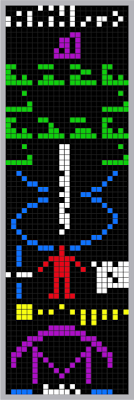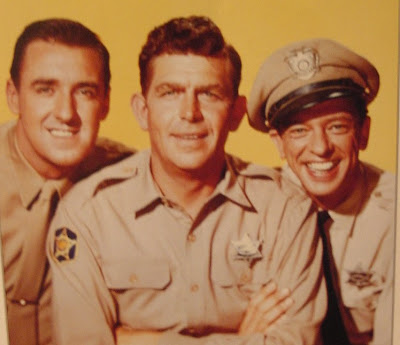The picture on the left went into space with our early interstellar craft (The Pioneers). It explains where earth is, what homo sapiens sort of looked like naked (like Barbie and Ken), and other information, like a diagram indicating the location of our sun.
Nasa's Jet Propulsion Lab (JPL) worked on this "Interstellar Outreach Program" for many years. The gold-plated disk is from the two Voyager craft, launched after the Pioneer. It is a bronze record containing sounds and images of life on earth. Each of the two Voyagers is equipped with a record player of sorts--with a cartridge, even--to play the disk, and recover the images.
The two circles in the bottom right side of the record show the two lowest states of a hydrogen atom. The vertical lines on the circles show the spin moment of the electron and proton. And (is this cool, or what?) "the transition time from one state to the next provides the fundamental clock reference used in ALL the cover diagrams and the images to be decoded from binaries." [Ed's note: Obviously, they're not expecting a dork like me to find the record laying around somewhere in the future].
Carl Sagan and a team of other folks designed and selected the Voyager's messages and data. The disk includes a greeting in 55 different languages, from Aramaic to Vietnamese. The record also includes a sampler of non-human Earth sounds such as wind, rain, surf, chimps, sheep, crickets, saws, and trains. It contains photos as well, and maps, diagrams of DNA, vertebrate anatomy charts, chemical and mathematical definitions, and other visual displays. The disk includes Beethoven, a Chuck Berry tune (Johnny B, Goode), Bach and Mozart, a Navajo chant, Indian Ragas, and a Louis Armstrong recording. There are 116 binary images on the record.
No one know if the aliens who find this will be able to use it, or decode the information. Will they even have hands? Opposable thumbs? Will they even think in any path parallel to ours? Will the disk just look like gibberish to them? Their scientists--if they have science (and we assume they must)--may need to study the disk for a couple of thousand years before they make a breakthrough.
A book titled Murmurs of the Earth, written by Sagan and colleagues, was reissued in 1992 with a CD-ROM compilation of the Golden Record, and a description of its creation. It's out of print, but you can pick up a copy fairly cheaply.
Don't hold your breath that any of our cousins in other galaxies will find this and come to visit. The Voyager will not come close to another star for something like 40,000 years. But then again, when you're dealing with our alien cousins Out There, 40,000 years may just be a sneeze in the winds of time.
Sounds included on the Voyager record:
- Music of The Spheres (WTF is this!?)
- Volcanoes, Earthquake, Thunder
- Mud Pots
- Wind, Rain, Surf
- Crickets, Frogs
- Birds, Hyena, Elephant
- Chimpanzee
- Wild Dog
- Footsteps, Heartbeat, Laughter
- Fire, Speech
- The First Tools
- Tame Dog
- Herding Sheep, Blacksmith, Sawing
- Tractor, Riveter
- Morse Code, Ships
- Horse and Cart
- Train
- Tractor, Bus, Auto
- F-111 Flyby, Saturn 5 Lift-off
- Kiss, Mother and Child
- Life Signs, Pulsar
Music:
- Bach, Brandenburg Concerto No. 2 in F. First Movement, Munich Bach Orchestra, Karl Richter, conductor. 4:40
- Java, court gamelan, "Kinds of Flowers," recorded by Robert Brown. 4:43
- Senegal, percussion, recorded by Charles Duvelle. 2:08
- Zaire, Pygmy girls' initiation song, recorded by Colin Turnbull. 0:56
- Australia, Aborigine songs, "Morning Star" and "Devil Bird," recorded by Sandra LeBrun Holmes. 1:26
- Mexico, "El Cascabel," performed by Lorenzo Barcelata and the Mariachi México. 3:14
- "Johnny B. Goode," written and performed by Chuck Berry. 2:38
- New Guinea, men's house song, recorded by Robert MacLennan. 1:20
- Japan, shakuhachi, "Cranes in Their Nest," performed by Coro Yamaguchi. 4:51
- Bach, "Gavotte en rondeaux" from the Partita No. 3 in E major for Violin, performed by Arthur Grumiaux. 2:55
- Mozart, The Magic Flute, Queen of the Night aria, no. 14. Edda Moser, soprano. Bavarian State Opera, Munich, Wolfgang Sawallisch, conductor. 2:55
- Georgian S.S.R., chorus, "Tchakrulo," collected by Radio Moscow. 2:18
- Peru, panpipes and drum, collected by Casa de la Cultura, Lima. 0:52
- "Melancholy Blues," performed by Louis Armstrong and his Hot Seven. 3:05
- Azerbaijan S.S.R., bagpipes, recorded by Radio Moscow. 2:30
- Stravinsky, Rite of Spring, Sacrificial Dance, Columbia Symphony Orchestra, Igor Stravinsky, conductor. 4:35
- Bach, The Well-Tempered Clavier, Book 2, Prelude and Fugue in C, No.1. Glenn Gould, piano. 4:48
- Beethoven, Fifth Symphony, First Movement, the Philharmonia Orchestra, Otto Klemperer, conductor. 7:20
- Bulgaria, "Izlel je Delyo Hagdutin," sung by Valya Balkanska. 4:59
- Navajo Indians, Night Chant, recorded by Willard Rhodes. 0:57
- Holborne, Paueans, Galliards, Almains and Other Short Aeirs, "The Fairie Round," performed by David Munrow and the Early Music Consort of London. 1:17
- Solomon Islands, panpipes, collected by the Solomon Islands Broadcasting Service. 1:12
- Peru, wedding song, recorded by John Cohen. 0:38
- China, ch'in, "Flowing Streams," performed by Kuan P'ing-hu. 7:37
- India, raga, "Jaat Kahan Ho," sung by Surshri Kesar Bai Kerkar. 3:30
- "Dark Was the Night," written and performed by Blind Willie Johnson. 3:15
- Beethoven, String Quartet No. 13 in B flat, Opus 130, Cavatina, performed by Budapest String Quartet 6:37
---o0o---






